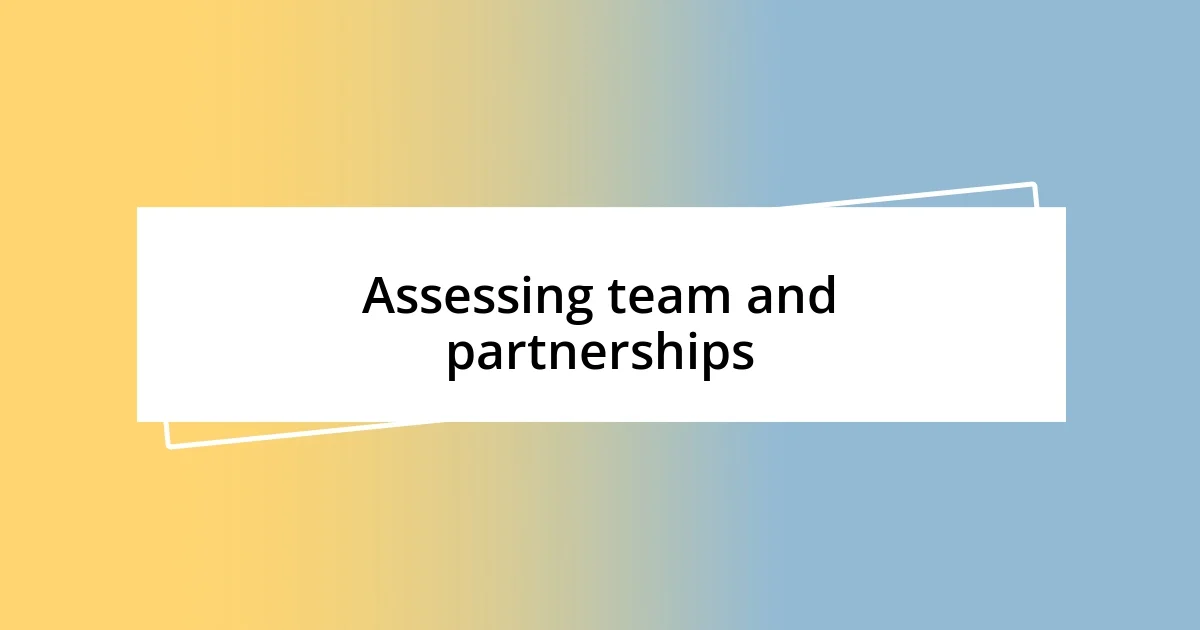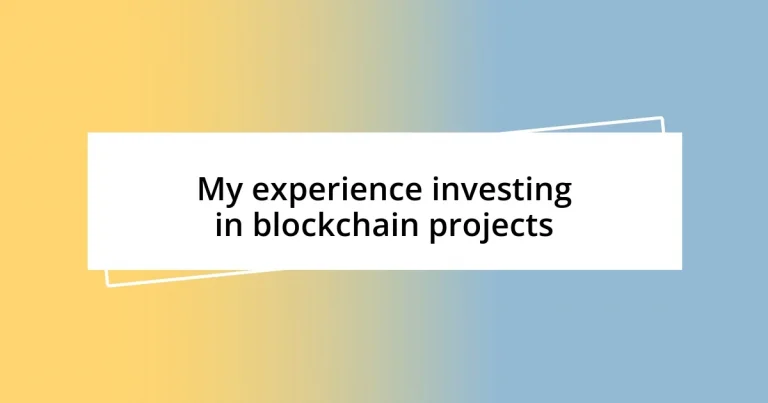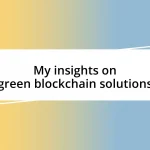Key takeaways:
- Understanding the fundamental differences between blockchain technology and cryptocurrencies is essential for informed investing.
- Evaluating potential blockchain projects involves thorough analysis of whitepapers, community feedback, and assessing the team’s credentials.
- Managing risks through diversification, ongoing education, and maintaining a patient investment strategy is crucial for long-term success in the blockchain space.

Understanding blockchain investment basics
Investing in blockchain projects can feel overwhelming at first, especially with all the new terminology involved. When I first started, I remember standing in front of my computer screen, staring at terms like “decentralization” and “smart contracts,” wondering if I would ever grasp what they really meant. It’s normal to feel a bit lost, but embracing that curiosity can lead to a rewarding journey.
One key aspect to understand is the difference between blockchain technology and cryptocurrencies. While cryptocurrencies like Bitcoin are built on blockchain, there are many projects that utilize this technology for various applications—ranging from supply chain management to digital identity verification. I vividly recall my excitement when I realized that blockchain’s potential goes beyond just trading coins; it felt like opening a door to a world filled with possibilities.
As you dip your toes into this space, it’s crucial to do your homework. I learned the hard way that not all projects are created equal. Some promise revolutionary change but lack substance. How can you differentiate between a gem and a scam? I started asking direct questions about a project’s team, goals, and technology—this changed everything for me and, I believe, will help you navigate the landscape with more confidence.

Evaluating potential blockchain projects
Evaluating potential blockchain projects requires a blend of intuition and analytical skills. When I first began assessing projects, I quickly realized that the project’s whitepaper is a treasure trove of information. I still remember dissecting a particularly well-crafted whitepaper, feeling a sense of excitement as I uncovered the team’s vision and technical solutions. It illuminated the pathway each project intended to tread, helping me gauge the realism of their claims.
Next, I learned the importance of community feedback. It was during a vibrant online forum discussion about a rising project that I gained valuable insights into public perception and potential red flags. Engaging with the community revealed not just praise but also concerns that were essential to consider. I often ask myself whether the project has an active community backing it—this can be a significant indicator of its viability.
Lastly, assessing the team behind the project is crucial. I once had a conversation with a fellow investor who emphasized the impact of a solid team on a project’s success. The better the credentials and previous successes of the team members, the more confidence I felt in moving forward. Whether it’s their backgrounds or past achievements, these details can significantly sway my opinion on a project’s potential.
| Criteria | Key Considerations |
|---|---|
| Whitepaper Quality | Detailed goals, technology explained, project feasibility |
| Community Engagement | Active discussions, user feedback, watches for red flags |
| Team Credentials | Experience, previous successes, industry reputation |

Analyzing project whitepapers effectively
When it comes to analyzing project whitepapers effectively, I’ve learned that it’s essential to dive deep into their structure and content. I vividly recall the first time I encountered a whitepaper that was overly complex—my excitement turned into confusion as I struggled to grasp the technical jargon. Now, I make it a point to focus on clarity and coherence. A good whitepaper should clearly articulate its vision, the problem it aims to solve, and the technology behind it. I often highlight the simple breakdown of its main concepts, as this clarity is what separates a promising project from a convoluted one.
Here are some key aspects to focus on:
- Clarity of Purpose: Does the whitepaper clearly state what the project intends to achieve?
- Technical Feasibility: Are the proposed technological solutions practical and well-explained?
- Market Understanding: Does the project demonstrate knowledge of its target market or industry?
- Roadmap and Milestones: Is there a realistic timeline for development and key deliverables?
- Tokenomics: Are the token distribution and utility clearly outlined, along with economic incentives?
By paying attention to these elements, I’ve found the process of evaluating projects becomes much more manageable, paving the way for smarter investment decisions. Each time I revisit my notes on what to look for, I feel more empowered to distinguish between innovation and mere hype in this fast-paced industry.

Assessing team and partnerships
One of the first lessons I picked up was the importance of the team’s background. When I first dove into a project, I recall being drawn to a team member’s impressive LinkedIn profile. It showcased a solid career in tech startups and a history of successful exits. Reflecting on this, I realized that the team’s expertise can often be a strong predictor of how well a project will navigate the unpredictable waters of the blockchain world. Ask yourself: do these individuals have a track record, or are they newcomers to the scene?
Moreover, partnerships can significantly bolster a project’s credibility. I remember one project that announced a collaboration with a well-respected blockchain incubator. This partnership gave me confidence; it suggested that the project had undergone rigorous scrutiny before being endorsed. It’s fascinating how network connections can enhance a project’s adaptability and access to resources. So, consider whether the project has established collaborations with industry veterans or organizations—they can often be the backbone of future success.
Lastly, I’ve found that understanding the team dynamic is equally important as their individual credentials. During one of my investment journeys, I stumbled upon an AMA (Ask Me Anything) session where the team interacted with the community. They displayed transparency and a collective passion for their project. It got me thinking, how engaged is the team with potential investors? A cohesive team that communicates openly can foster trust and, ultimately, loyalty among its supporters, which is essential for any blockchain venture.

Recognizing market trends and signals
Recognizing market trends and signals can feel like navigating a maze, but I’ve found that certain indicators can guide my way. For instance, I remember a moment when I noticed a surge in social media discussions about a specific blockchain project. That buzz was my first signal to dive deeper, revealing insights about community sentiment that often precede market movements. I often ask myself, “What’s the crowd saying?” because the pulse of the community often reflects future price actions.
Another aspect I’ve found crucial is tracking the trading volume. I once overlooked a project because it seemed stagnant, only to later see a sudden spike in trading volume that hinted at growing interest. It’s fascinating how sometimes the quietest days can give way to explosive activity. I’ve come to understand that a sharp increase in volume can indicate either strong interest or the potential for volatility. I now regularly check volume trends before making any decisions; it’s like having a crystal ball into market intent.
Additionally, I pay close attention to news cycles and regulatory developments. I vividly recall the day a major blockchain regulation was announced—projects that adapted quickly thrived, while others struggled to keep up. This taught me that external factors often shape market sentiment. I urge you to stay informed because, in this space, knowledge is power. What trends are emerging, and how could they impact your investments? Embracing this perspective has revolutionized my approach to investing in blockchain projects.

Managing risks in blockchain investments
Managing risks in blockchain investments is a nuanced endeavor that often requires both intuition and research. During one of my early investments, I fell prey to the allure of potential gains without fully understanding the project’s whitepaper. I spent hours grappling with terms like “consensus mechanism,” which, in hindsight, I realized I should have comprehended fully. This experience taught me that grasping the project’s fundamentals is critical. How can you invest in something you don’t truly understand?
Diversification has also been a lifesaver for me. When I reflected on my portfolio, I saw that overinvesting in a single project had previously caused me sleepless nights. I remember feeling a wave of anxiety when market volatility hit. Since then, I’ve made it a priority to spread my investments across various projects. Isn’t it more comforting to know that if one doesn’t perform well, others might still carry your portfolio?
Lastly, I can’t stress enough the value of ongoing education and community engagement. I recall attending an online webinar that dove deep into the mechanics of tokenomics. Listening to experts dissect real-world use cases helped me identify red flags and opportunities. I often ask myself, where can I learn more? Engaging with the community not only enhances my knowledge but also provides insights that can help mitigate risks in a rapidly changing environment.

Strategies for long-term success
One strategy I’ve adopted for long-term success is staying patient and committed to my investments. I recall a time when I was tempted to sell a project after a minor dip, spurred by the fear of loss. But after reminding myself of the project’s solid fundamentals, I held on. That decision paid off tremendously, highlighting how emotional reactions can cloud judgment. So, I often ponder, how much do we let fear dictate our financial choices?
Another critical aspect of my strategy has been to engage in regular portfolio reviews. It’s easy to get caught up in the day-to-day market fluctuations, but I’ve learned to step back and assess the bigger picture. I remember the sense of clarity I felt during one of these reviews when I identified several projects that were no longer aligned with my goals. This reflection not only sharpened my focus but also renewed my motivation. How regularly do you take a moment to evaluate where your investments are taking you?
Finally, I emphasize the importance of maintaining a network of fellow investors and industry experts. I can’t tell you how many invaluable insights I’ve gained from informal discussions over coffee or virtual meetups. Just the other day, a friend shared an article about emerging blockchain technologies that shifted my perspective on where to allocate resources next. Engaging in these conversations leads to unexpected opportunities and keeps my investment strategies fresh and informed. Isn’t it fascinating how collaboration fuels growth in such a dynamic field?














